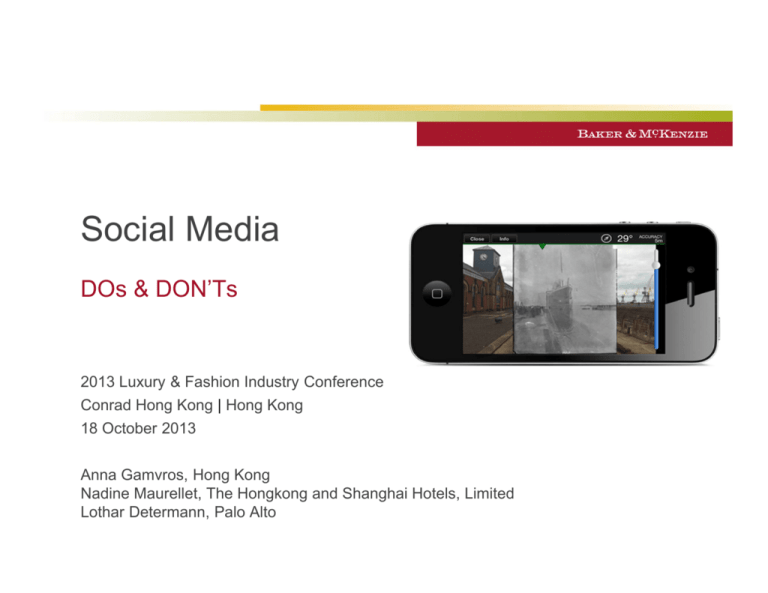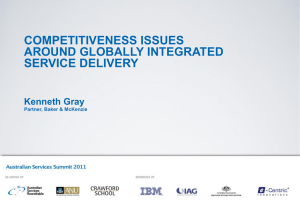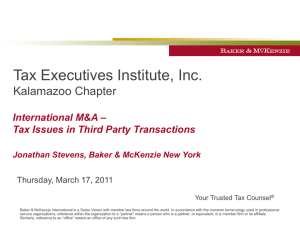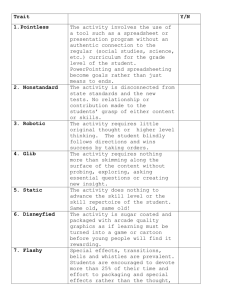Social Media - Are You Prepared? Checklist
advertisement

Social Media DOs & DON’Ts 2013 Luxury & Fashion Industry Conference Conrad Hong Kong | Hong Kong 18 October 2013 Anna Gamvros, Hong Kong Nadine Maurellet, The Hongkong and Shanghai Hotels, Limited Lothar Determann, Palo Alto Social Media – What is it (for)? © 2013 Baker & McKenzie 2 How Companies Use Social Networks – Increase communication, collaboration, productivity of employees – – Reach and engage candidates, employees who grow up with Social media marketing is different - it is conversational, less controlled. Encourage customer postings about companies and their products which are communicated instantly to their friends Encourage customers to share things about themselves, e.g. photos, videos, ideas and information – – – – – Offer promotions and benefits if you “Like” them or say nice things about their products Use location based services to contact user locally and let user’s contacts know where they are Track customer search behavior and social media use in order to deliver advertising targeted to consumer’s interests All of these uses are of great value in communicating a company’s message and encouraging customers to make it viral, but also raise serious privacy and data protection compliance issues © 2013 Baker & McKenzie 3 Check: Ready for Social Media? 1. Are you using the social media platforms you need and for appropriate purposes? 2. Do you own what you think you own? 3. Is your data privacy compliance program ready for social media? 4. Are your employee policies up to date with respect to social media? 5. Does your HR group know what to do? 6. Is your IT department on top of new social media technologies? 7. Are sales and marketing under control? 8. Have you considered industry-specific, regulatory requirements? 9. Are you regulating too much? 10. Are you training enough? 11. Do you know the latest and coolest social media application? © 2013 Baker & McKenzie 4 Advertising and Customer Engagement – mere presence: advertising and consumer protection laws – push: labelling, product liability, misrepresentation and trade practices laws – viral marketing: anti-spam laws – interactive: astroturfing, IP infringement, public policy © 2013 Baker & McKenzie 5 Case Study – Who owns the buzz? MultiNatCo grows sales of its microbrew with a very successful, young and dynamic marketing team that includes: – – – – – Rolf who already has 66,666 followers on Twitter under his @muchbetterbeer account, but then Rolf leaves for BigBadCompetitor and keeps using his account, Susi who ocassionally uses her Facebook account to update her friends about special beer tasting events, but who is not amused about Tom keeping up the updating business while she is on maternity leave for a while, Ulrich who pays for upgraded LinkedIn accounts for all employees who want one (presuming that this means the connections belong to MultiNatCo now), Victor who instructs co-workers to write positive Yelp reviews about MultiNatCo and key restaurants that feature MultiNatCo beer, Walter who manages investor commmunications (in close cooperation with legal) but also runs a private blog where he talks more freely about how well the company is going and the beer markets more generally. © 2013 Baker & McKenzie 6 Case Study - Checklist – Decide whether to allow personal social media accounts for certain business purposes and / or establish proprietary social media platform – Prepare form agreement for employees about account / information transition upon termination and verify compatibility with social media platform terms of use – Update rules on prior legal review requirements for employee communications and cover reviews, blogs, social media posts © 2013 Baker & McKenzie 7 Case Study – Discrimination, Bullying & Harassment – – Your company has launched an internal social media networking site, OurPlace, for employees to connect and share ideas with colleagues. The company has installed monitoring software to check OurPlace for offensive or potentially discriminatory language. The software has picked up the following exchange: Employee A You know, I was here til midnight last night finishing that report for Bill after you left… 1 day ago Employee B Sorry about that – I had to get home in time for the child minder. Thanks v much for sorting it out! 1 day ago Employee A I guess I shouldn’t be surprised really – you working moms are such slackers 1 day ago – You also discover further posts where A describes B as a “lazy b*tch”. B has not reported any of these posts to you © 2013 Baker & McKenzie 8 Checklist - Discrimination, Bullying & Harassment – – Employers can be vicariously liable for discrimination and harassment by their employees Your social media policy should take steps to prevent such behavior, and should: 2 1 Remind employees that discrimination and harassment is prohibited, including in internal and external social media sites © 2013 Baker & McKenzie 3 Broadly define discrimination and harassment Clearly explain the potential sanctions for breach of the policy, up to and including termination 9 my profile Case Study – Background Screening Home News Friends Games ACME, a US multinational approximately two months away from applying for Safe Harbor certification, posts a "help wanted" ad on its website for a position in the UK. Gil, a resident of Maryland, submits a humorous and compelling e-application from his hotel in Paris. Gil's clever application is routed to Jane, ACME's London based recruiting coordinator, to her friend Sam, an independent contractor assigned by his employer to help install a new HR data system at ACME's US headquarters, with the cover note "I guess you aren't the only State U alum with a sense of humor.“ Sam does a quick Google check on Gil, and becomes Gil's Facebook friend two days later, thanks to an introduction from a mutual friend and fellow State U alum. Sam's Facebook profile lists his current employer, but does not mention anything about his assignment to ACME. In reviewing Gil's Facebook page, Sam learns that Gil has filed and settled two discrimination charges against his last two employers, is about to file bankruptcy due to credit card debts, is a devout member of a small religious sect that believes Doomsday is imminent, and is seeking prayers as he begins treatment for a recently diagnosed neuromuscular disease. Gil asks that his "friends" keep his diagnosis under wraps, as he has yet to break the news to his parents and is waiting for the right time to do so. Sam emails Jane at her ACME address as follows: "Subject: State U Alum with Sense of Humor Jane, Don't put me in the same boat with this loser. He's got many issues—radioactive." The next day ACME informs Gil that he will not be among the finalists for the position. Does ACME have any legal risks? © 2013 Baker & McKenzie End of the world supplies on sale! Happy birthday! Call my bankruptcy line now! 10 Checklist: Social Media and Background Screens – – – – – – – – Create locally compliant guidelines for conducting background screens Harmonize the screening process with the employer's antidiscrimination policies Restrict screening to HR and authorized vendors Establish compliance program to allow for cross-border personal data flows Monitor local law developments--US law is especially problematic in this space Segregate the decisionmaker from the investigator Ensure that the decisionmaker has "clean hands" Beware the long arm of FCRA © 2013 Baker & McKenzie 11 Employee Monitoring: US – Generally, can destroy expectation of privacy, but: Electronic Communications Privacy Act State anti-wiretapping statutes Common law claims, e.g., invasion of privacy © 2013 Baker & McKenzie 12 Employee Monitoring: ROW Requirements – Europe: Different culture and stricter rules – Some of the challenges: Live monitoring Preventive monitoring Data related to private use Employee consent Blocking statutes Adequacy requirement for international data transfers Special confidentiality requirements (works council, DPO) Two party consent requirement © 2013 Baker & McKenzie 13 Employee Monitoring: EU Checklist – Transparency, proportionality, limitation of purpose – Works council consultation – Works council agreement – DPO involvement – Acceptable use and monitoring policy – DPA filings/authorization for data transfers – Retention periods – Processing registers © 2013 Baker & McKenzie 14 Making Your Social Media Policy © 2013 Baker & McKenzie Considerations When Drafting a Global Social Media Policy Prescribe, prohibit or permit? © 2013 Baker & McKenzie 16 Contents of a Global Social Media Policy − Monitoring − Ownership of Social Media Accounts and Relationships − Protection of Confidential and Proprietary Information − Personal Use During Working Hours − Discrimination & Harassment − Defamation & Denigration of the Company − Endorsements − Direct Marketing / Spam − Consequences of Violations of the Social Media Policy © 2013 Baker & McKenzie 17 Structure of Global Social Media Policies – General vs. Job-Specific Protocols – Global vs. Regional vs. Country-Specific Policy © 2013 Baker & McKenzie 18 Implementation of a Global Social Media Policies in ROW – Translations – Notification and Consultation with Works Councils and Employee Representative Committees – Implementation as Part of Internal Regulations or Work Rules © 2013 Baker & McKenzie 19 Enforcement and Training © 2013 Baker & McKenzie 20 Questions? © 2013 Baker & McKenzie 21 Social Media DOs & DON’Ts 2013 Luxury & Fashion Industry Conference Conrad Hong Kong | Hong Kong 18 October 2013 Lothar Determann, Palo Alto Anna Gamvros, Hong Kong Nadine Maurellet, The Hongkong and Shanghai Hotels, Limited







